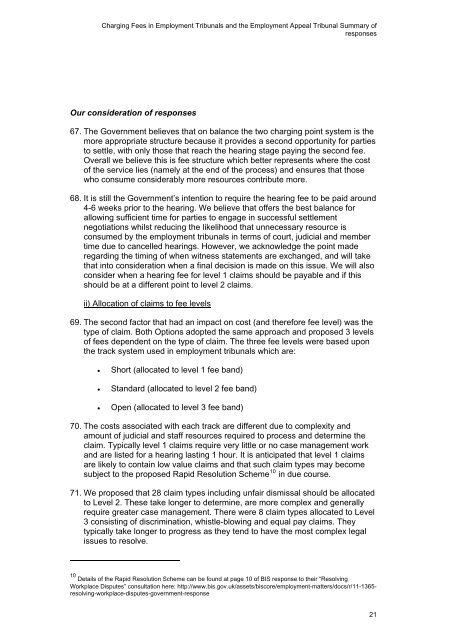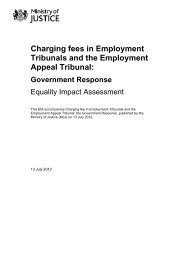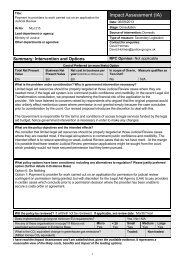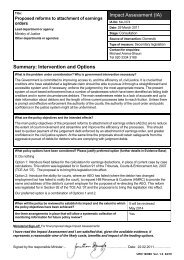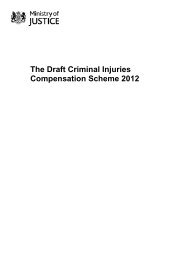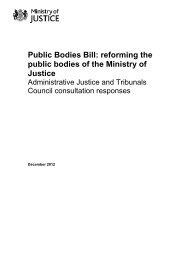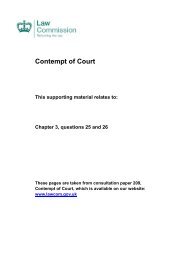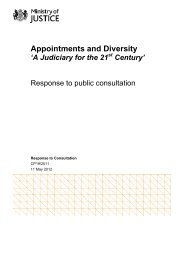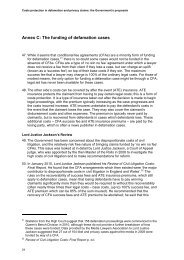Charging Fees in Employment Tribunals and the ... - Ministry of Justice
Charging Fees in Employment Tribunals and the ... - Ministry of Justice
Charging Fees in Employment Tribunals and the ... - Ministry of Justice
Create successful ePaper yourself
Turn your PDF publications into a flip-book with our unique Google optimized e-Paper software.
<strong>Charg<strong>in</strong>g</strong> <strong>Fees</strong> <strong>in</strong> <strong>Employment</strong> <strong>Tribunals</strong> <strong>and</strong> <strong>the</strong> <strong>Employment</strong> Appeal Tribunal Summary <strong>of</strong>responsesOur consideration <strong>of</strong> responses67. The Government believes that on balance <strong>the</strong> two charg<strong>in</strong>g po<strong>in</strong>t system is <strong>the</strong>more appropriate structure because it provides a second opportunity for partiesto settle, with only those that reach <strong>the</strong> hear<strong>in</strong>g stage pay<strong>in</strong>g <strong>the</strong> second fee.Overall we believe this is fee structure which better represents where <strong>the</strong> cost<strong>of</strong> <strong>the</strong> service lies (namely at <strong>the</strong> end <strong>of</strong> <strong>the</strong> process) <strong>and</strong> ensures that thosewho consume considerably more resources contribute more.68. It is still <strong>the</strong> Government’s <strong>in</strong>tention to require <strong>the</strong> hear<strong>in</strong>g fee to be paid around4-6 weeks prior to <strong>the</strong> hear<strong>in</strong>g. We believe that <strong>of</strong>fers <strong>the</strong> best balance forallow<strong>in</strong>g sufficient time for parties to engage <strong>in</strong> successful settlementnegotiations whilst reduc<strong>in</strong>g <strong>the</strong> likelihood that unnecessary resource isconsumed by <strong>the</strong> employment tribunals <strong>in</strong> terms <strong>of</strong> court, judicial <strong>and</strong> membertime due to cancelled hear<strong>in</strong>gs. However, we acknowledge <strong>the</strong> po<strong>in</strong>t maderegard<strong>in</strong>g <strong>the</strong> tim<strong>in</strong>g <strong>of</strong> when witness statements are exchanged, <strong>and</strong> will takethat <strong>in</strong>to consideration when a f<strong>in</strong>al decision is made on this issue. We will alsoconsider when a hear<strong>in</strong>g fee for level 1 claims should be payable <strong>and</strong> if thisshould be at a different po<strong>in</strong>t to level 2 claims.ii) Allocation <strong>of</strong> claims to fee levels69. The second factor that had an impact on cost (<strong>and</strong> <strong>the</strong>refore fee level) was <strong>the</strong>type <strong>of</strong> claim. Both Options adopted <strong>the</strong> same approach <strong>and</strong> proposed 3 levels<strong>of</strong> fees dependent on <strong>the</strong> type <strong>of</strong> claim. The three fee levels were based upon<strong>the</strong> track system used <strong>in</strong> employment tribunals which are:Short (allocated to level 1 fee b<strong>and</strong>)St<strong>and</strong>ard (allocated to level 2 fee b<strong>and</strong>)Open (allocated to level 3 fee b<strong>and</strong>)70. The costs associated with each track are different due to complexity <strong>and</strong>amount <strong>of</strong> judicial <strong>and</strong> staff resources required to process <strong>and</strong> determ<strong>in</strong>e <strong>the</strong>claim. Typically level 1 claims require very little or no case management work<strong>and</strong> are listed for a hear<strong>in</strong>g last<strong>in</strong>g 1 hour. It is anticipated that level 1 claimsare likely to conta<strong>in</strong> low value claims <strong>and</strong> that such claim types may becomesubject to <strong>the</strong> proposed Rapid Resolution Scheme 10 <strong>in</strong> due course.71. We proposed that 28 claim types <strong>in</strong>clud<strong>in</strong>g unfair dismissal should be allocatedto Level 2. These take longer to determ<strong>in</strong>e, are more complex <strong>and</strong> generallyrequire greater case management. There were 8 claim types allocated to Level3 consist<strong>in</strong>g <strong>of</strong> discrim<strong>in</strong>ation, whistle-blow<strong>in</strong>g <strong>and</strong> equal pay claims. Theytypically take longer to progress as <strong>the</strong>y tend to have <strong>the</strong> most complex legalissues to resolve.10 Details <strong>of</strong> <strong>the</strong> Rapid Resolution Scheme can be found at page 10 <strong>of</strong> BIS response to <strong>the</strong>ir “Resolv<strong>in</strong>gWorkplace Disputes” consultation here: http://www.bis.gov.uk/assets/biscore/employment-matters/docs/r/11-1365-resolv<strong>in</strong>g-workplace-disputes-government-response21


